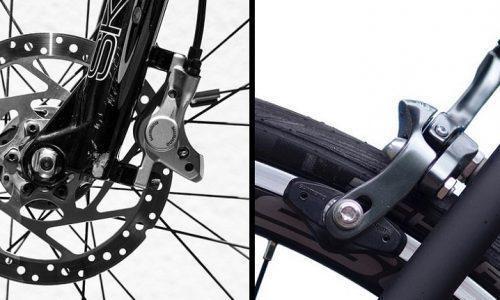Key Takeaways: Steel and Aluminum are two distinct materials used in bike frames: Steel is strong, flexible, durable, easy to repair, and cost-effective but heavy and less responsive, while Aluminum is lightweight, strong, responsive, and cost-effective but has a lower fatigue level, is stiffer, and more difficult to repair.
The choice between the two depends on the intended use of the bike, with Steel being ideal for long-distance touring and Aluminum better suited for racing and fast riding.
Introduction
When it comes to cycling, two materials that have been around the industry for a long time are Steel and Aluminum. They are both metals, but very few people actually know the difference between them.
In this article, we are going to tell you all about them both so next time you’re in the market for a new bike, you know what to go for.
What is Steel?
Steel is an alloy of iron and carbon containing less than 2% carbon and 1% manganese and small amounts of silicon, phosphorus, sulfur, and oxygen.
It has been used on bikes since day one and still is to this day. We’re seeing modern bikes being built with steel even though many other material alternatives are available.
What are the Pros and Cons of Steel?
Pros
Strength
Steel is incredibly strong and can not only carry huge loads but also take a good knock if you were to drop your bike.
Steel isn’t a brittle material, so you don’t have to worry about it cracking on impact, and there’s much less chance of you over-tightening a bolt and damaging the frame because of this.
Flexibility
Steel has an incredible ability not just to be strong but also to be flexible. Steel bike frames soak up bumps perfectly, and you will find that when pushed to a limit, they are able to flex a lot before eventually breaking.
They last for a very long time
 Steel does last for a very long time, providing you don’t let it rust. With a protective layer of paint, steel bikes will go on forever, and they don’t fatigue easily like carbon or aluminum.
Steel does last for a very long time, providing you don’t let it rust. With a protective layer of paint, steel bikes will go on forever, and they don’t fatigue easily like carbon or aluminum.
The fatigue point is so high on steel that your barely ever pushing it to its limit, so it will just keep on going.
Easy to Repair
Steel is very easy to repair compared to other materials.
It can literally just be welded onto, and if you do end up breaking it, any half-decent welder would be able to patch it back up.
Cost
Steel frames are very cheap to buy and build frames with. It is the go to material for custom frame builders because of this and the fact it is very easy to weld with basic equipment.
Cons
Heavy
Although steel has some amazing qualities being lightweight isn’t one of them. Steel bikes naturally are pretty heavy, and getting them to be lighter is very challenging.
Less Responsiveness
Unlike carbon and aluminum, steel isn’t as responsive. It takes longer to transfer the power from your pedals, and this is because of that flexibility.
What is Aluminum?
Aluminum is a lightweight silvery white metal of main Group 13 (IIIa, or boron group) of the periodic table.
It was first seen on a bike in the 1970s, and it has very different qualities from steel. Although they are both metals, they don’t share the same characteristics.
What are the Pros and Cons of Aluminum?
Pros
Lightweight
Aluminum is a very lightweight material, and because of this, it does benefit you when it comes to riding your bike. One statistic we all look into before buying most bikes is the weight, and the frame makes a big difference.
Strength
Aluminum, like steel, is very strong. It is also quite brittle in its strength and doesn’t have much flexibility, so it is more than likely to crack under heavy pressure.
Responsiveness
Aluminum is very responsive, and like materials like carbon, it is very stiff. This makes the power transfer much better, and it does feel much more agile because you’re not working against the flexibility.
 Cost
Cost
Just like steel, it’s very cheap to produce aluminum, but it has to be done in the right conditions. You can get racing aluminum frames very cheap compared to other materials like carbon fiber.
Cons
Low Fatigue Level
Unlike Steel, aluminum has a lower fatigue level, and because of this, you often push it to its limits. It can only go there a certain amount of times before it wants to crack.
This is why they say aluminum frames only have a life of 5-10 years.
Stiff
Although the stiffness of an aluminum bike does give it responsiveness, it also does make it quite unforgiving on bumps and can be a little uncomfortable depending on the terrain you are on.
Very difficult to repair
Unlike steel, aluminum is very challenging to repair. Typically it works out cheaper with most frames just to buy a whole new frame if it breaks.
Steel or Aluminum, which is better for your frame?
They are both excellent materials and both suit different situations in my opinion. If you are looking for a bike for long-distance touring, then steel, by far, is your best bet.
It can carry more luggage, will last much longer, and that flexibility will go a very long way in keeping you comfortable.
If you are looking for a bike to race and go fast on, then aluminum is going to be your best friend. It’s stiff, lightweight, and it’s fast to ride.
These qualities are the perfect combination for a racing bike, especially for beginners in case they drop or crash it.
Conclusion
When it comes to aluminum or steel, the best thing to do is go for the bike fit for the job you want to do. Both materials are incredible when it comes to bikes, and whichever you choose, you will get some incredible benefits.
Expert Tip
If you can’t decide between steel and aluminum, try looking into titanium. It combines the best of both materials and is beautiful to look at.

Robbie Ferri has spent years working in a bike shop, has worked with industry leading brands on product creation, has been a semi pro athlete, and is a fully qualified strength and conditioning coach. He has broken World Records, bikepacked all over the World and raced ultra distance at a top-level.







Only a 5-10 year life on Aluminum, seriously? I guess I need to retire my 2008 Cannondale Road Warrior pretty soon then. I ride that bike on all surfaces and expect it to last another 15 years.
I do agree on steel. It lasts a lifetime. I have a ‘73 Schwinn Varsity, which is crazy heavy, 41# with chrome fenders, but indestructible. I also have two ‘84 Le Tours which only weigh 28#, but are strong and soak up bad roads.
Great article, my compliments. I have a 30-year-old 1992-1993 Gary Fisher Super Caliber and love it. I ride it road, cross-country, downhill, enduro, you name it. Worth mentioning that, not all aluminum is alike. My frame is 7,000-series aluminum (7005) and I have literally put it through everything you can think of, and not a crack. I’m 6’2″ and a fit 220, which says a lot for my bike brand, build, and frame, being pushed to it’s limits.